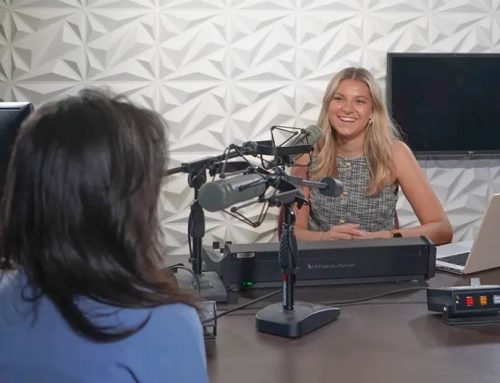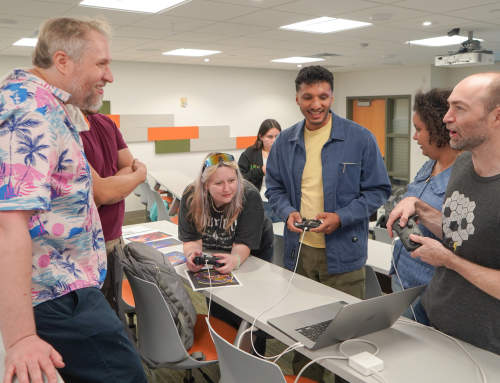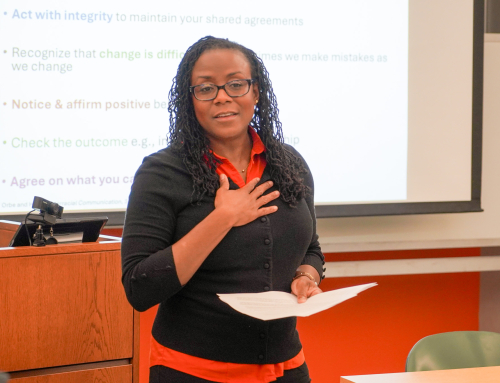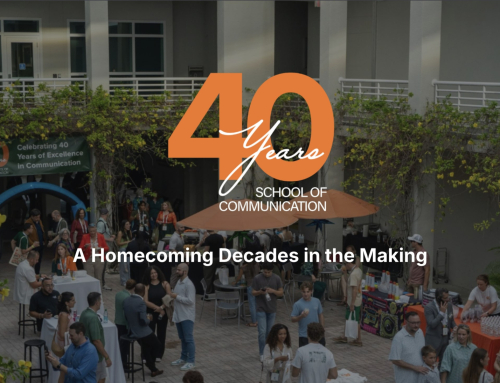How has the communications landscape changed?

School of Communication Dean Karin Wilkins. Photo: Abbie Bernet/University of Miami
By Barbara Gutierrez
11-06-2024
This story originally appeared on News@TheU.
In 1980, more than 62.2 million American households received a daily newspaper at home. Consumers got their national television news from three major television networks: ABC, CBS, and NBC. Magazines were growing in popularity.
People received most calls on a landline telephone at home. An apple was a fruit, not a mega electronics company that permeates daily lives.
Communication has evolved tremendously in the past four decades. The University of Miami School of Communication will be 40 years old next year, and it has been a protagonist in these remarkable changes.
The school had its beginning in 1926 as a two-credit public speaking course offered at the College of Arts and Sciences, but by 1984 plans were finalized for its opening as a full-fledged school within the University. Interest in journalism peaked during the 1980s, after the Watergate scandal —which forced President Richard Nixon to resign—was brought about by excellent investigative reporting by two journalists at The Washington Post.
The advent of the internet, social media, and the iPhone, which debuted in 2007, revolutionized the communication landscape. Reporters and others had access to the world and new technologies that made their work easier. Consumers had many more choices for news and entertainment.
School of Communication Dean Karin Wilkins sees the changes in communication this way: “Communication technologies represent a significant change in our daily lives, not only across the last 40 years, but even in the last four. Our personal and professional worlds are different from the speed at which we connect, the growing numbers of people in our immediate network, and the ways in which we communicate as families, as citizens, and as consumers.”
Wilkins was recently chosen to lead the Alliance of Schools and Colleges of Communication and Journalism, an organization of deans sharing policies, practices, and patterns that guide strategic planning.
She reminds us that although much has changed, “at heart our human needs to form community, to trust, and to create endure.”
Sallie Hughes, professor and chair of the Department of Journalism and Media Management, remembers using a manual typewriter as editor of The Independent Florida Alligator student newspaper at the University of Florida.
She believes that the financial decline of newspapers began in the 1980s as the corporate models for most daily newspapers demanded quick profits for investors. Internet-based aggregators further peeled away revenues in the 1990s, even before the social media revolution.
A deeper transformation began in the 2000s as people looked to their messaging apps for news, and news became nationalized and opinion-based on cable news programs. Coverage of local news, important for local democracy and found mostly in newspapers, suffered as a result, she said.
If we only focus on legacy newspapers or their websites, however, we completely miss the important developments in digital local news, Hughes added. Local news in digital native outlets with smart journalists reporting fact-based information for the public good is still a force for democracy.
“All encompassing newspapers have declined, but we are seeing community-based digital news outlets survive, many of them as nonprofits or with more diverse sources of funding,” she said. “Local journalism is vibrant, but also more fragmented.”
She cites a plethora of digital outlets, such as the Key Biscayne Independent, a local nonprofit news site that covers that community, as well as Florida beat reporters for the environmental news site Floodlight News and for Politico, as examples of successful digital native news sources that are providing important local information.
At the national level, the track record is more mixed. Commercial outlets Buzzfeed and Politico are among the national digital sites that make profits through news and entertainment, experts said, while ProPublica is an example of a newer national model that is nonprofit and collaborative, co-creating important stories with local and regional media.
In the broadcast world, everything began to change 40 years ago. It was in 1980 that CNN launched its 24-hour news channel. Now there are hundreds of cable channels offering news and entertainment.
Gina Presson, lecturer and former broadcast reporter and producer with more than 30 years of experience, remembers those days.
“I worked for CNN as a producer and other networks called us ‘chicken noodle’ news because people did not believe we could sustain it,” she said. “But CNN did change the landscape, and it encouraged local news and network news to expand its coverage.”
As the new technologies increase possibilities, Presson warns her students not to let the 24-hour news cycle allow them to lose sight of accuracy and “checking their sources.” She spends time on the ethics of journalism, on giving a voice to the voiceless, and the importance of being the watchdogs of government.
“It is critical that they know that journalism matters,” she said. “If we don’t ask the hard questions [of politicians], no one will have the answers, and that is not useful to the electorate.”
Ana Francois, assistant professor of practice, has noticed that students communicate digitally much better than previous generations.
“They just need to understand forces driving media industries and the effects they’re having on individuals and societies,” said Francois, who is also associate department chair of journalism and media management. “With so much disinformation and misinformation out there, it is more important than ever to be media literate.”
One big change that affects the electorate is the rise of partisan journalism. While in the 1980s communicators were taught to cover news objectively and keep opinion out of news pieces, now there are channels devoted to one political point of view, and commentators play a greater role in newscasts, said Presson.
Students are also expected to carry out a multitude of tasks when they enter the communications field. The school is training the new communicators to be nimble, she said.
“People who are in broadcast journalism now are being asked to also write print and digital stories, and the print people are being asked to write broadcast stories,” Presson said. “At the end of the day, it is about the story. Whether it is print, radio, TV, or digital, it is our privilege and responsibility to tell these stories and to keep people informed.”
To keep pace with the changes and the advent of artificial intelligence (AI), the School of Communication has established a task force to study how to integrate AI into is curriculum, inspired by support from the Lynn and Louis Wolfson II Family Foundation.
It also offers a rich number of multimedia courses that include creating videos and podcasts, as well as a media entrepreneurship class that helps students launch their own media companies. And recognizing the rise of influencers who display their messages in social media channels to millions of fans, the department is creating classes to teach students research skills and ethics to improve the content, said Hughes.
The school has continued to evolve, offering programs of study in areas including advertising, communication studies, interactive media, journalism, media management, motion pictures, public relations, and global social change. That two-credit public speaking course has evolved into five thriving departments with state-of-the-art learning spaces.
Journalism and communication continue to draw students who want to make a difference in this world, said the professors interviewed.
Jenny Jacoby is a senior and editor-in-chief of The Miami Hurricane student newspaper, who majors in ecosystem science and policy and political science. She has been reporting and writing since high school and knows that journalism is a challenging career undergoing many changes.
“I know journalism may not be the best field to make money and cannot be compared to investment banking,” she said. “But I want to start out in something that I am passionate about. Journalism is always different. You are always learning something new, talking to new people, and you get to see the impact that you have on a community.”






